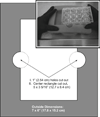Studying mucin secretion from human bronchial epithelial cell primary cultures
- PMID: 22259142
- PMCID: PMC5151171
- DOI: 10.1007/978-1-61779-513-8_16
Studying mucin secretion from human bronchial epithelial cell primary cultures
Abstract
Mucin secretion is regulated by extracellular signaling molecules emanating from local, neuronal, or endocrine sources. Quantifying the rate of this secretion is important to understanding how the exocytic process is regulated, and also how goblet/mucous cells synthesize and release mucins under control and pathological conditions. Consequently, measuring mucins in a quantitatively accurate manner is the key to many experiments addressing these issues. This paper describes procedures used to determine agonist-induced mucin secretion from goblet cells in human bronchial epithelial (HBE) cell cultures. It begins with primary epithelial cell culture, offers methods for purifying MUC5AC and MUC5B mucins for standards, and describes five different microtiter plate binding assays which use various probes for mucins. A polymeric mucin-specific antibody is used in standard and sandwich ELISA formats for two assays while the others target the extensive glycosylated domains of mucins with lectin, periodate oxidation, and antibody-based probes. Comparing the data derived from the different assays applied to the same set of samples of HBE cell cultures indicates a qualitative agreement between baseline and agonist stimulated mucin release; however, the polymeric mucin-specific assays yield substantially lower values than the assays using non-specific molecular reporters. These results indicate that the more nonspecific assays are suitable to assess overall secretory responses by goblet cells, but are likely unsuited for specific measurements of polymeric mucins, per se.
Figures



References
-
- Thornton DJ, Rousseau K, McGuckin MA. Structure and function of the polymeric mucins in airways mucus. Annu. Rev. Physiol. 2007;70:459–486. - PubMed
-
- Sheehan JK, Kirkham S, Howard M, Woodman P, Kutay S, Brazeau C, Buckley J, Thornton DJ. Identification of molecular intermediates in the assembly pathway of the MUC5AC mucin. J. Biol. Chem. 2004;279:15698–15705. - PubMed
-
- Davis CW, Dickey BF. Regulated airway goblet cell mucin secretion. Annu. Rev. Physiol. 2008;70:487–512. - PubMed
-
- Danahay H, Jackson AD. Epithelial mucus-hypersecretion and respiratory disease. Curr. Drug Targets. Inflamm. Allergy. 2005;4:651–664. - PubMed
Publication types
MeSH terms
Substances
Grants and funding
LinkOut - more resources
Full Text Sources

